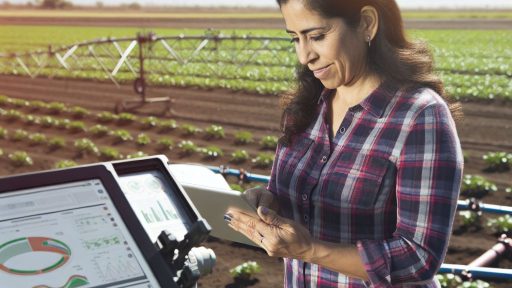Introduction to Climate-Resilient Agriculture
Climate-resilient agriculture plays a vital role in modern farming practices.
This approach addresses challenges posed by climate change.
Farmers increasingly face unpredictable weather patterns.
Moreover, these changes directly impact crop yield and quality.
Understanding Climate Resilience
Climate resilience refers to the ability of agricultural systems to adapt and recover.
These systems can thrive amidst changing environmental conditions.
Farmers must implement strategies that promote sustainability.
In this context, resilience yields better returns on investment over time.
Key Principles of Climate-Resilient Practices
Several principles guide effective climate-resilient agriculture.
- Diversity in crops improves ecosystem balance.
- Improved soil health combats erosion and nutrient depletion.
- Water management is crucial for crop sustainability.
Additionally, integrating local knowledge enhances resilience strategies.
Farmers like Alex Greene emphasize the importance of these practices.
Benefits of Climate-Resilient Agriculture
Climate-resilient agriculture offers a range of benefits.
- It helps to stabilize food production.
- Farmers can reduce input costs over time.
- There is increased adaptability to market changes.
Consequently, these advantages contribute to higher overall ROI.
In fact, many early adopters report significant gains in productivity.
Case Studies and Evidence
Examining successful case studies illustrates tangible outcomes.
Transform Your Agribusiness
Unlock your farm's potential with expert advice tailored to your needs. Get actionable steps that drive real results.
Get StartedFor example, the Johnson family farm implemented crop rotation successfully.
This strategy reduced pest outbreaks and improved yields significantly.
Furthermore, adopting cover cropping practices increased soil health.
These examples highlight the vast potential of climate-resilient methods.
Understanding ROI in Agriculture
Defining Return on Investment
Return on investment (ROI) measures the profitability of an agricultural venture.
It compares net income to the initial investment cost.
Farmers can use this metric to assess the effectiveness of their strategies.
Higher ROI indicates a more profitable operation.
Key Metrics for Evaluating ROI
Several metrics help farmers evaluate their ROI more effectively.
- Net profit margin reflects overall profitability.
- Yield per acre assesses land productivity.
- Cost of production identifies how efficiently resources are used.
Each metric provides valuable insights into different aspects of farm performance.
Importance of Sustainable Practices
Sustainable practices contribute to long-term ROI goals.
They enhance soil health, reduce input costs, and increase resilience.
Thus, integrating sustainability into farming operations is essential.
Calculating ROI in Agriculture
Calculating ROI involves a straightforward formula.
The formula is: (Net Profit / Cost of Investment) x 100.
Farmers can apply this formula to evaluate different projects.
Consistency in calculations ensures better comparisons over time.
Utilizing Technology for Enhanced ROI
Technology plays a crucial role in maximizing ROI.
Precision agriculture tools help optimize inputs and enhance yield.
Additionally, data analytics aids in decision-making and performance tracking.
Incorporating tech solutions leads to informed choices and resource efficiency.
Assessment of Current Farmland Practices and Their Vulnerabilities
Introduction to Current Practices
Farmers today utilize various practices on their farmland.
These practices often prioritize short-term yields and profits.
Unfortunately, they can lead to long-term vulnerabilities.
Showcase Your Farming Business
Publish your professional farming services profile on our blog for a one-time fee of $200 and reach a dedicated audience of farmers and agribusiness owners.
Publish Your ProfileCommon Agricultural Practices
Conventional tillage remains a prevalent approach.
This method disrupts soil structure and depletes nutrients.
Chemical fertilizers are widely used for quick nutrient supply.
However, they contribute to soil degradation over time.
Impact of Climate Change
Climate change significantly affects farming practices.
Increased temperatures influence crop growth and yields.
Moreover, erratic weather patterns disrupt planting and harvesting.
Farmers face unexpected droughts and floods more often.
Soil Health Concerns
Soil health is critical for sustainable agriculture.
Current practices often neglect organic matter replenishment.
Consequently, soil erosion and compaction become critical issues.
Healthy soil is essential for water retention and nutrient cycling.
Economic Vulnerabilities
Short-sighted practices can lead to increased production costs.
Farmers may struggle with fluctuating market prices.
Therefore, economic vulnerability arises from dependency on inputs.
This cycle can jeopardize long-term farm viability.
Adapting to Changing Conditions
Farmers must adapt to environmental changes for resilience.
Current practices require evaluation for adaptability.
Innovative approaches can help mitigate vulnerabilities.
Promoting sustainable practices can improve financial stability.
Identifying Future Risks
Future risks include more extreme weather events.
Farmers need to consider these challenges in their planning.
Understanding vulnerabilities will guide the adoption of resilience strategies.
This includes focusing on diversified crop rotations and responsible land management.
Explore Further: Drought and Flood Risks for Agricultural Real Estate Investors
Technologies Enhancing Climate Resilience in Agriculture
Precision Agriculture
Precision agriculture uses technology to optimize field-level management.
This approach enhances crop yields and reduces waste.
Farmers utilize data analytics for informed decision-making.
Additionally, GPS and sensors allow for real-time monitoring.
Soil Health Management
Maintaining healthy soil is crucial for sustainable agriculture.
Techniques such as cover cropping improve soil structure.
Organic amendments boost nutrient levels naturally.
Furthermore, soil management enhances water retention capabilities.
Water Conservation Technologies
Water-efficient irrigation systems save valuable resources.
Drip and sprinkler systems minimize water loss.
Rainwater harvesting captures and stores rainfall for agriculture.
Moreover, moisture sensors aid in timely watering decisions.
Climate-Resilient Crop Varieties
Biotechnology enables the development of resilient crop varieties.
These crops withstand extreme weather events, ensuring reliability.
Farmers select varieties that thrive in changing climates.
Showcase Your Farming Business
Publish your professional farming services profile on our blog for a one-time fee of $200 and reach a dedicated audience of farmers and agribusiness owners.
Publish Your ProfileThis practice ultimately enhances food security.
Data-Driven Decision Making
Data analytics plays a vital role in modern agriculture.
Farmers analyze trends to forecast challenges and opportunities.
Additionally, mobile applications provide real-time market insights.
Consequently, farmers can make informed economic decisions.
Sustainable Pest Management
Integrated pest management reduces reliance on chemical pesticides.
This method promotes the use of beneficial insects and natural predators.
Farmers adopt biopesticides to control pest populations effectively.
Overall, sustainable methods protect both crops and the environment.
Explore Further: The Impact of Climate Change on Irrigation and Sustainable Farming
Diversification Strategies
Crop Selection for Resilience
Diversifying crops significantly enhances farm resilience.
Different crops respond uniquely to climate variations.
This diversity helps mitigate risks associated with market fluctuations.
Consider incorporating drought-resistant varieties, such as sorghum and millet.
Also, grow legumes to improve soil health and nitrogen levels.
Rotating crops can break pest and disease cycles effectively.
Implementing a mix of cash and cover crops is beneficial, too.
Cover crops also protect soil from erosion and improve moisture retention.
By adapting to specific local conditions, farmers maximize their yield potential.
Livestock Diversification
Diversifying livestock species can enhance farm stability.
Integrating sheep or goats with traditional cattle can optimize land use.
These animals can eat different types of forage, reducing competition.
Consider rotational grazing to improve pasture health.
This strategy increases the biodiversity of plants in grazing areas.
Adding poultry can provide additional income and pest control.
Chickens, for example, consume insects and contribute manure for fertilization.
Designing a mixed-species farming system fosters ecological balance.
Managing Financial Risks
Crop and livestock diversification can cushion financial risks.
Multiple income streams help stabilize cash flow across seasons.
Unpredictable weather patterns can severely impact single-crop farmers.
However, diversified operations can offset losses in underperforming areas.
Establishing contracts with local markets can secure revenue.
Participating in community-supported agriculture offers consistent sales opportunities.
Ultimately, diversified farming systems can enhance profitability long-term.
Uncover the Details: Sustainable Farming Practices for Real Estate Landowners

Soil Management Techniques for Sustainability and Productivity
The Importance of Soil Health
Soil health directly influences agricultural productivity.
Healthy soil enhances nutrient availability and water retention.
Moreover, it supports root development and microbial activity.
Better soil health leads to improved crop yields over time.
Implementing Crop Rotation
Crop rotation diversifies plant species grown on the same land.
Showcase Your Farming Business
Publish your professional farming services profile on our blog for a one-time fee of $200 and reach a dedicated audience of farmers and agribusiness owners.
Publish Your ProfileThis practice breaks pest and disease cycles effectively.
Additionally, it enhances soil structure and fertility.
Farmers benefit from reduced reliance on chemical fertilizers.
Consequently, crop rotation promotes ecosystem resilience.
Utilizing Cover Crops
Cover crops protect and enrich the soil between main crops.
They prevent erosion and enhance organic matter content.
Furthermore, cover crops suppress weeds naturally.
Legumes, for instance, add nitrogen to the soil efficiently.
Adopting Conservation Tillage
Conservation tillage minimizes soil disturbance during planting.
This method preserves soil structure and moisture levels.
It also reduces erosion and enhances carbon sequestration.
Farmers often experience long-term benefits to soil fertility.
Integrating Organic Amendments
Organic amendments improve soil nutrient content and structure.
Compost and manure enrich the soil with vital nutrients.
These materials enhance microbial diversity and activity.
Using organic amendments generally leads to healthier crops.
Employing Soil Testing and Monitoring
Soil testing helps identify nutrient deficiencies and pH levels.
Regular monitoring allows precise nutrient management.
Farmers can tailor their soil management strategies effectively.
This proactive approach maximizes productivity sustainably.
Compost Application Techniques
Applying compost improves soil structure and fertility.
Top-dressing is a common application method for established crops.
Cultivation incorporates compost into the soil but requires caution.
Consistent compost application supports long-term soil health.
Water Management Practices
Effective water management is crucial for soil sustainability.
Irrigation systems should minimize water loss during usage.
Drip irrigation delivers water directly to plant roots efficiently.
Additionally, rainwater harvesting enhances water availability.
Continuous Learning and Adaptation
Farmers should stay informed about new soil management techniques.
Participating in workshops and training can enhance skills.
Networking with other farmers fosters knowledge sharing.
Adapting practices based on research leads to better outcomes.
Learn More: Drone Technology for Climate-Resilient Farming and Property Valuation
Water Management Practices to Optimize Irrigation and Reduce Waste
Importance of Efficient Water Use
Efficient water use enhances crop productivity while conserving resources.
Farmers can significantly lower operational costs by minimizing water waste.
Moreover, efficient use helps in maintaining sustainable agricultural practices.
Adopting Smart Irrigation Technologies
Smart irrigation technologies adjust water delivery based on real-time data.
For example, soil moisture sensors prevent over-irrigation.
Additionally, weather forecasting tools help plan irrigation schedules effectively.
Implementing Drip Irrigation Systems
Drip irrigation delivers water directly to the plant roots.
Showcase Your Farming Business
Publish your professional farming services profile on our blog for a one-time fee of $200 and reach a dedicated audience of farmers and agribusiness owners.
Publish Your ProfileThis method reduces evaporation and runoff, promoting efficient water use.
Farmers find that crops receive consistent moisture, boosting yield quality.
Rainwater Harvesting Techniques
Harvesting rainwater can supplement irrigation needs significantly.
Farmers can store rainwater in tanks for use during dry periods.
This practice conserves groundwater and helps mitigate drought impacts.
Monitoring and Maintaining Soil Health
Healthy soil retains more water, making it essential for irrigation efficiency.
Farmers can improve soil health through organic amendments and cover crops.
Healthy soil contributes to better water absorption and nutrient delivery.
Training and Education for Farmers
Providing training on water management is crucial for farmers.
Workshops can teach techniques on efficient irrigation practices.
Farmers can share experiences and solutions with peers to promote innovation.
Establishing Water Conservation Plans
Developing water conservation plans helps manage resources effectively.
These plans outline strategies for reducing water usage during peak seasons.
Regular assessments ensure that practices adapt to changing conditions.
Policy and Financial Incentives for Climate-Resilient Farming Solutions
Government Policy Support
Governments are increasingly recognizing the importance of climate-resilient agriculture.
They implement policies that promote sustainable farming practices.
These policies often include subsidies for adopting new technologies.
Additionally, regulatory frameworks may favor eco-friendly farming methods.
Farmers benefit from grants aimed at enhancing their sustainability efforts.
Financial Incentives for Farmers
Financial incentives play a crucial role in encouraging farmers.
Low-interest loans can help farmers invest in climate-resilient practices.
Tax credits are also available for those who choose sustainable technology.
Moreover, crop insurance programs protect against climate-related losses.
Partnerships and Collaborations
Collaboration is vital for achieving resilience in agriculture.
Farmers can partner with research institutions for innovative farming techniques.
Public-private partnerships often fund resilient farming initiatives.
These collaborations can lead to shared knowledge and resources.
Community Engagement and Education
Engaging local communities enhances climate resilience.
Education initiatives inform farmers about sustainable practices.
Workshops and training sessions can empower farmers to adapt.
Community support networks encourage the sharing of best practices.
Global Initiatives
International organizations promote sustainable agriculture on a global scale.
Global funds support projects focused on climate adaptation in farming.
Such initiatives create opportunities for farmers in developing regions.
Collaboration across borders helps share successful strategies.
Additional Resources
From Farm to Kitchen: The Environmental Impacts of U.S. Food Waste
Opportunities to Address Climate Change in the Next Farm Bill …




